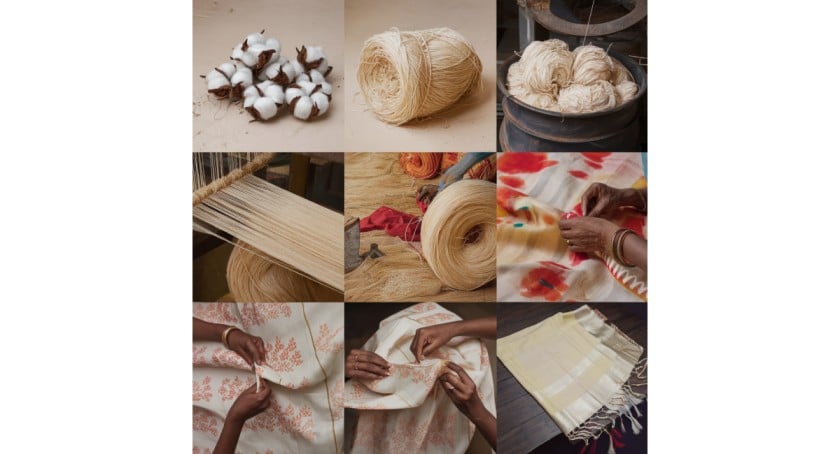The Making of a Cotton Saree: The Art of Crafting
A rhythmic dance unfolds in the heart of India’s weaving clusters, between the weaver’s hands and the loom, between raw cotton and breathtaking artistry. The soft clack-clack of wooden looms fills the air as freshly spun yarn releases its scent, and generations-old craftsmanship radiates warmth. This is where a humble thread transforms into an exquisite handmade cotton saree, a six-yard marvel draped in heritage and love.
But have you ever wondered how artisans create this timeless masterpiece? How do threads evolve into a flowing, breathable, graceful fabric? Buckle up because we are about to take you on an exhilarating journey through crafting a handmade cotton saree’s meticulous, labor-intensive, and utterly magical process.
Cultivating the Foundation, Cotton to Yarn
Before artistry takes over, nature plays its part. The journey of a handmade cotton saree begins in sprawling cotton fields, where fluffy white cotton bolls sway gently under the sun. Farmers carefully pluck these soft tufts, ensuring only the finest quality makes it to the next stage.
Once harvested, cotton undergoes ginning, a process that separates the fibers from the seeds. Pure, soft cotton remains, ready to be spun into yarn. This is where tradition meets technique. In small villages and artisanal hubs, spinning wheels, known as charkhas, hum as they twist cotton fibers into fine, delicate threads. The result? A strong yet soft yarn that serves as the lifeline of the saree weaves intricate patterns effortlessly, enhancing its elegance and durability.
The Alchemy of Dyeing, A Splash of Color
A cotton saree without color is like a sky without stars; it lacks magic. The dyeing process infuses life into the yarn, turning it into a canvas of vibrancy. Traditional artisans often use natural dyes derived from plants, flowers, and minerals, ensuring that each thread carries an organic touch.
First, artisans treat the yarn with a mordant, a special agent that helps the dye adhere. Then, they dip it into vats of colors like deep indigos, fiery reds, royal greens, and earthy yellows. Using age-old tie-and-dye techniques, they create intricate patterns on some sarees. After multiple dips and washes, they leave the dyed threads to dry under the sun, allowing them to soak in nature’s warmth.
The Art of Warping and Weaving, A Symphony on the Loom
Now comes the most intricate stage, the heart and soul of saree making. The dyed yarn is first starched and stretched out on long wooden beams for warping. This step ensures that each thread aligns perfectly, creating the base structure of the saree.
Once the weaver warps the threads, they meticulously mount them onto a handloom, where the real magic begins. The weaver, often trained from childhood, works with unparalleled precision, moving the shuttle back and forth, interlacing the weft (horizontal threads) with the warp (vertical threads).
This is a slow, patient art. Depending on its complexity, each saree takes a few days to several weeks to complete. Some weavers even incorporate intricate motifs inspired by nature, folklore, or geometry, crafting patterns that are nothing short of poetry woven in thread.
Grand Finishing, A Touch of Perfection
The final saree is ready but not yet perfect. Before it graces a wardrobe, it undergoes an essential finishing process. Traditional artisans carefully check the fabric for inconsistencies, loose threads, or minor weaving errors. They often use a burnishing stone or wooden mallet to gently smooth out the fabric, giving it a soft sheen.
Finally, they wash the saree in clear water, sun-dry it, and carefully fold it. Some artisans adorn the pallu’s edge with delicate tassels, while others leave it with a raw, unpolished charm. This is when a simple weave transforms into a piece of wearable history, creating an heirloom for someone to drape.
Why Handmade Cotton Sarees Are a Treasure?
A handmade cotton saree is not just an outfit; it is a labor of love, a testament to patience, and a tribute to age-old craftsmanship. Unlike machine-made fabrics, it breathes, flows, and ages gracefully, getting softer with every wash. Here’s why it holds a special place in the world of textiles:
- Eco-Friendly Elegance: No harmful chemicals or excessive water usage; just pure, sustainable fashion that respects the planet, empowers artisans, and promotes ethical, eco-friendly production practices.
- A Work of Art: Each saree carries the unique signature of its weaver, making no two pieces exactly alike.
- Unmatched Comfort: Feather-light, airy, and perfect for any climate, especially in the sweltering summers.
- A Heritage Piece: Owning one is like holding a fragment of history woven with stories of generations.
A Saree with a Soul
The next time you drape a handmade cotton saree, pause momentarily. Feel its texture, trace its patterns, and appreciate the hands that crafted it. It is a whisper of tradition, a melody of hard work, and a timeless tribute to the artisans who keep this legacy alive.
So, the next time you buy a saree, remember: you are not just purchasing a garment but appreciating a piece of India’s soul.


